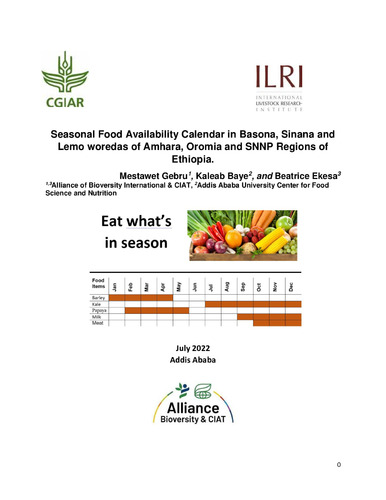Seasonal food availability calendar in Basona, Sinana and Lemo woredas of Amhara, Oromia and SNNP regions of Ethiopia
Seasonality is one of the key factors in determining food availability, especially of perishable foods like fruits and vegetables. Having multiple seasonal food-availability data provides a better understanding of the type of foods available in a given area/region. Therefore, a second round of seasonal food-availability assessments was conducted using participatory action research in three Africa RISING intervention areas to support its nutrition objectives. Data was collected in October 2021 through Focus Group Discussions (FGDs) and Key Informant Interviews (KIIs). The same enumerators were used for the first and second round survey, except for Lemo district. A second training/refresher was given to the enumerators to ensure full and common understanding of the tools (they were trained during the first-round survey). The same participants who were involved in the first-round survey were interviewed – these included experienced farmers and merchants familiar with seasonal dynamics of foods and involved a balance of men and women with a balanced mix of ages, diverse ethnicity, and economic status.
A total of 75 participants were involved through 12 FGDs and 8 KIIs in the study. Participants were asked to list all the food items available for consumption in the community and to specify the months that each food item is available. Each food item was categorized into a food group based on Mean Dietary Diversity -Women methodology guidebooks like: Grains, white roots and tubers = 1; Pulses = 2; Nuts and seeds =3; Meat, Poultry and Fish = 4; Eggs = 5; Dark green leafy vegetables (DGLV) =6; Other Vitamin A-rich fruit and =7; Other vegetables= 8; Other fruits =9; and Milk and other dairy products = 10. The levels of availabilities each month and each food item were scored on a scale of 0 to 3 in which 0 represents – no availability; 1 represents low availability; 2 represents moderate availability and 3 for high availability. The average of the availability score across all the focus groups was taken to integrate the dataset and average availability of each species was calculated for each month. A color scale was applied using conditional formatting in Excel.
The results have been organized into three sections based on geographical area including information about diversity, culinary use, source of species, and seasonal availability of the different food species. The overall availability of foods in the area in each month was summarized by food groups. For example, in Basona Woreda in Amhara Region, N/Shewa Zone, the availability of cereals was high to moderate from December to April. However, availability of nuts was low the entire year. Moderate availability of meat, poultry and fish was documented from December to February. Dark green leafy vegetables were moderately available from July to December. Whereas other vitamin A-rich fruits and vegetables were low through the year. For most of the year, there was no availability of species of “other fruits”. Milk and other dairy products were only available for four months a year. In Sinana woreda, Oromia region, cereals and pulses were available from high to moderate levels for eight months a year. However, nuts were only available for three months a year and no availability for the rest of the year. Meat, poultry and fish, eggs, other vitamin A-rich fruits and vegetables and other fruits were low for most of the year. Other vegetables and milk and other dairy products were moderately available from July to January. In Lemo woreda, dark green leafy vegetables ranked top for highly available foods from all food groups, eight months a year, followed by other fruits and other vitamin A-rich fruits and vegetables. Eggs were low the entire year. Based on the information gathered, a seasonal food availability calendar was developed using a color gradient to represent the availability of food species. The finding of this research supported the idea that conducting a second round of seasonal food availability assessments enables a better knowledge of the kinds of foods that are readily available in the locally.
Overall, compared to other food groups, cereals’ diversity and availability were slightly better in all districts. Very limited number of food items were identified under DGLVs in all districts. Other V-A rich vegetables and fruits were entirely low in diversity and availability in Basona and Sinana districts and relatively better in Lemo district. For most of the year, there was little perceived availability of nuts, meat, poultry and fish. This result implies a significant gap in the intake of fruits, vegetables, and animal products which calls for more intervention on nutrient dense food production that would broaden diet options and substantially enhance the nutrition status. To strengthen food security through diet diversification especially concerning the lean periods, nutrition interventions should be put in place.

